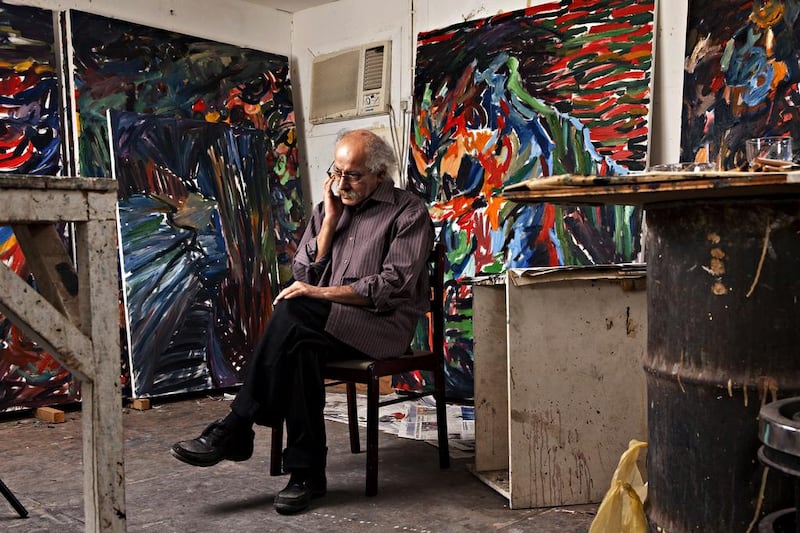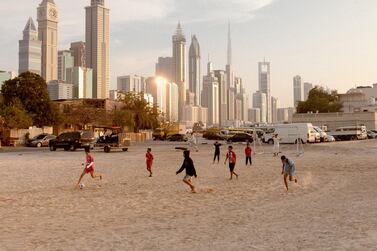It was almost a decade after the creation of the UAE that its art scene started to take shape.
In the 1980s, the country’s contemporary art scene revolved around five key figures who gathered with intellectuals and writers to discuss ideas and who worked together to put on exhibitions for the public.
These Emirati artists – Hassan Sharif, his brother Hussain Sharif, Abdullah Al Saadi, Mohammed Kazem and Mohamed Ahmed Ibrahim – came to be known as the "Group of Five" or "The Five" because of their participation in the 2002 exhibition titled 5 UAE, held in Germany.
Though they worked in different mediums, they bolstered the UAE art scene and influenced a generation of artists in the region.
Over the years, their practices have gained more attention abroad, with a recent travelling exhibition of Hassan's work, and Ibrahim's next show planned for the Venice Biennale 2022.
So who are “The Five” and what are they known for? Here’s a quick look at the first wave of contemporary artists in the UAE.
Hassan Sharif
Perhaps the most prominent among them was Hassan, who died in 2016. Born in Dubai in 1951, he studied at Byam Shaw School of Art in London in the late 1970s and returned to the UAE in 1984. His home in Satwa became the meeting point for many writers and artists, and also became an atelier for other artists.
His work was largely conceptual and experimental – his work with assemblage and sculpture is his most recognisable. These objects, as he called them, were made using industrial materials or cheap, everyday products that were mass-produced.
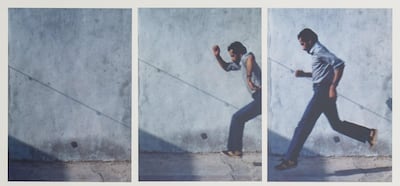
In 1980, he helped found the Emirates Fine Arts Society in Sharjah, where most of the other artists in the group met. Since 1993, his pieces were often featured in the Sharjah Biennial, and in 2017, the first major retrospective of his work was shown at the Sharjah Art Foundation.
The exhibition titled I Am The Single Work Artist travelled to the KW Institute for Contemporary Art in Berlin this year and is currently on its second iteration at Malmo Konsthall in Sweden.
Mohammed Kazem
When Kazem was 14 years old, he dropped out of school and went to the Emirates Fine Arts Society instead, where he learnt from Hassan.
Born in 1969, Kazem's wide-ranging practices include photography, performance, video and installation. His focus includes the notion of mapping, as seen in his famous work Directions, where he applies GPS co-ordinates to ordinary locations.
He completed his master’s in fine art at the University of the Arts in Philadelphia in 2012, and has participated in numerous shows in the UAE and abroad. In 2013, Kazem represented the UAE at the Venice Biennale.
![DUBAI, UNITED ARAB EMIRATES - SEPTEMBER 27, 2018.
Mohammed Kazem infront of his series "Even the Shade does not Belong to Them" at his solo show "A Prime Activity", in Gallery Isabelle van den Eynde.
The show focuses on his paintings – a relatively unknown aspect of his practice. Kazem has been painting since his late teens and early 20s, went on to win the first prize in painting at Muscat Youth Biennial in 1990 and loved the surface so much that he remained consciously aware to the inspiration coming from the medium itself.
While painting remained a major aspect of Kazem’s early practice, now more than 30 years later, he is still fascinated by collecting and documenting information about unimportant objects and traces of our present within a particular environment. In his monograph published in 2013, Hassan Sharif wrote, “The meaning or purpose of his [Kazem’s] paintings lies in the life of the colours and the ways they can be put to use, not in the painted objects themselves.”
(Photo by Reem Mohammed/The National)
Reporter: Melissa Gronlund
Section: AC](https://thenational-the-national-prod.cdn.arcpublishing.com/resizer/v2/Q4LXJ4J3W57XTLCGD3CI4QE2KI.jpg?smart=true&auth=47e2a511c1447af6ac1b8ec06fcd6e0ffbb239698553db849b222585b0cbaa8e&width=400&height=266)
His recent paintings have turned towards more social concerns, particularly the condition of labourers. The series Even the Shade Does Not Belong to Them from 2018 features dark paintings of men at construction sites. The subjects seem to disappear into the background, with Kazem seemingly blending them into the structure they are creating, as a comment on their invisibility.
Mohamed Ahmed Ibrahim
A Khor Fakkan native, Ibrahim has always been inspired by the natural landscape of his home. Growing up close to the mountains, he would explore his surroundings and appreciate the materials and forms in them.
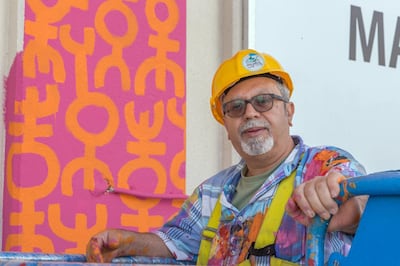
In a September interview with The National, he recalled: "This was the beginning of my special relationship with nature, when I was 16 or 17. I began to deal with it as if it were a human being, as if there was a soul in it. I started to become a friend to it. When I'd go into nature, I would use natural materials like clay, branches, leaves, grass, stones, but I wouldn't break the branches. I didn't bother the creatures in the mountains. I just used the materials that I found in the land." In turn, his sculptures appear primordial.
He began taking part in exhibitions in the late 1980s with the encouragement of Hassan. It was through these activities that Ibrahim came to meet Kazem and Al Saadi.
Ibrahim, who is now in his late 50s, has been selected to represent the UAE at the next Venice Biennale, which will take place in 2022.
Abdullah Al Saadi
Like Ibrahim, Al Saadi was also fascinated by the land. Also from Khor Fakkan, he was born in 1967, and studied English literature in Al Ain and eventually Japanese painting in Kyoto. His practice differs from the other artists in the group in that Al Saadi was most interested in showcasing his work in rural settings.
His land art encompasses environmental installations, as well as the intricate and detailed categorisation of found objects, from stones to dead insects.
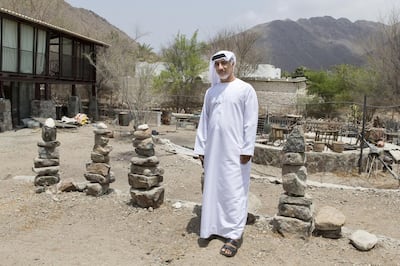
In a way, he has always been a collector, as his habit of gathering objects goes back to high school, when he also began recording his memories of the UAE art scene. He would then turn these objects into artworks. His sculptures, such as the series The Cavity Room, feature installations made of skulls, bones and horns of animals in Khor Fakkan.
His project Letters from My Mother, created between 1998 to 2000, exemplify the artist's fixation with categorisation. His mother, who lived close to his home in Khor Fakkan, would sometimes drop in for a visit, but would find that Al Saadi wasn't home.
Unable to read or write, his mother would leave a sign in the form of a stone, paper, piece of string, metal or wood. Al Saadi collected these objects, numbering them and then trying to create a system out of them.
The artist, who still lives in Khor Fakkan, had his works shown at the Venice Biennale in 2011 and 2015.
Hussain Sharif
Born in 1961, Hussain, like his older brother Hassan, is a conceptual artist. He was active in the 1980s and 1990s, often helping emerging artists develop their practices through workshops.
Primarily concerned with materiality and scale, he has worked with cement, metal, wood and plastic. For the artist, these objects are typically used in construction and daily life, but are also easily discarded and considered as remnants.
His 1995 work Installation, for example, features cement and found objects arranged neatly and in order on the floor. With the use of repetition, Hussain sought to conjure a kind of meaning to the randomness and "meaninglessness" of the selected items.
His creative career is varied, he studied theatre design in Kuwait and eventually joined Sharjah TV as a designer. For a period, he also worked as a caricaturist for daily newspapers and magazines in the UAE.
Referring to himself as an "art activist", Hussain often participated in the discussions held at his brother Hassan's residence and was active in the Emirates Fine Arts Society.
His other works include constructivist drawings adorning public spaces, which are considered one of the earlier examples of street art in Dubai.
